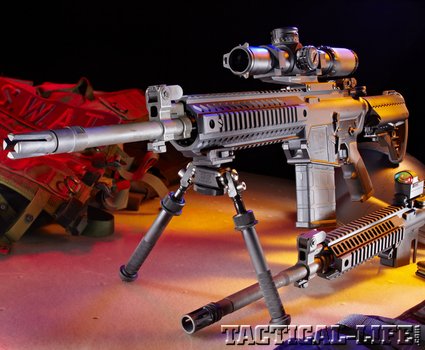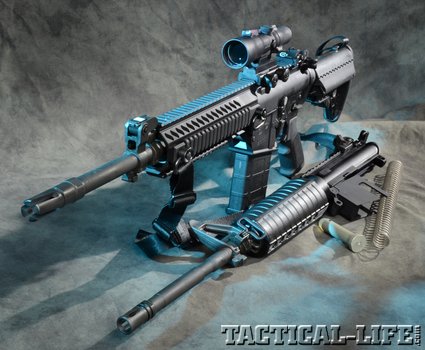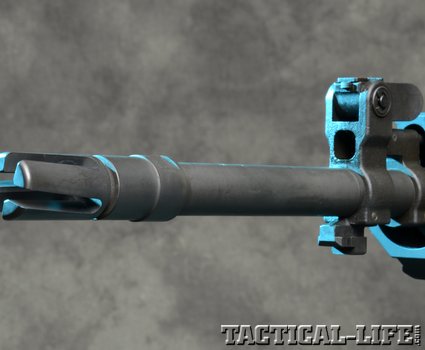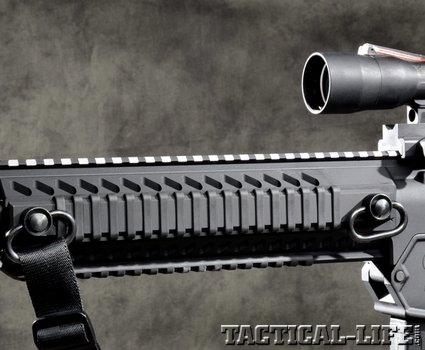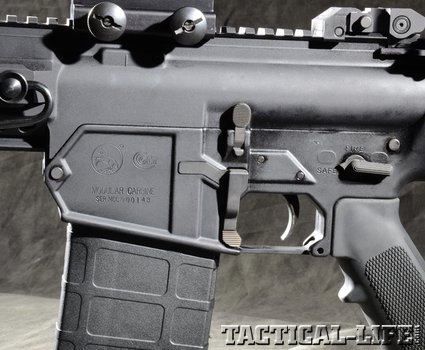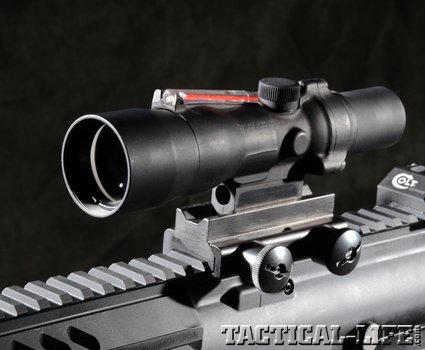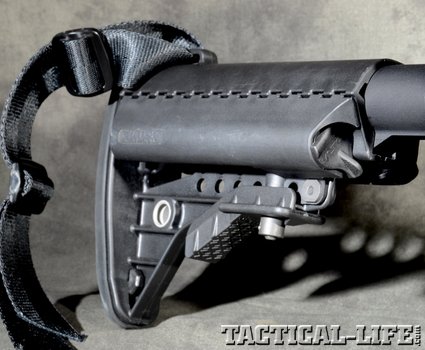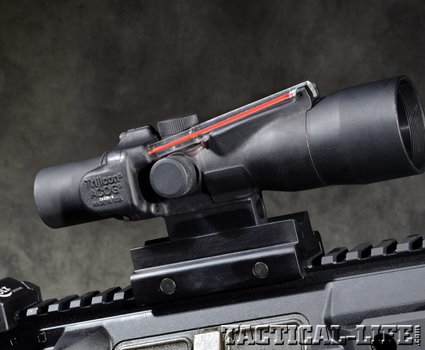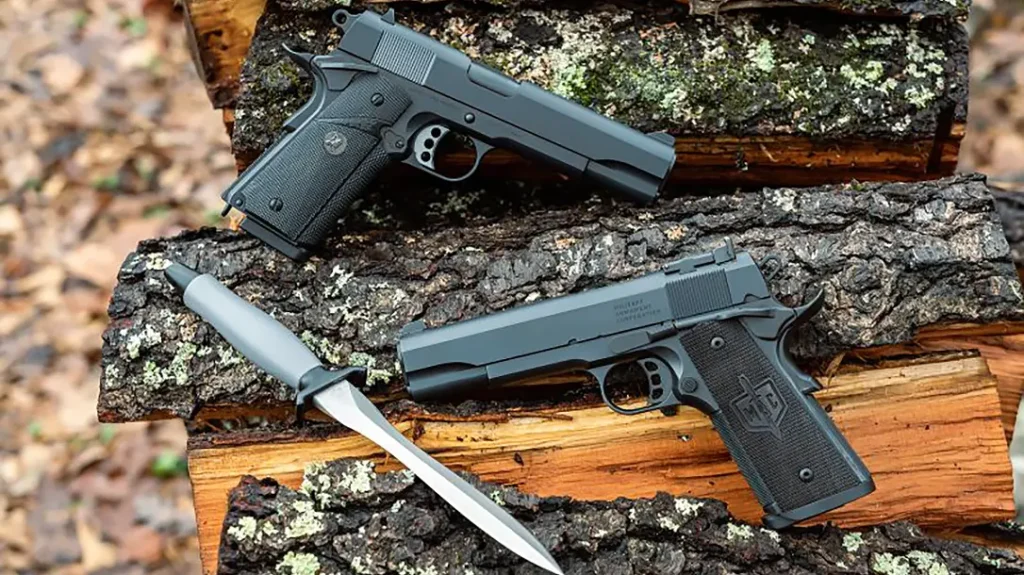Currently, the typical law enforcement patrol rifle is a semi-auto M4 carbine. A few agencies go with the military 14.5-inch barrel, but most choose the 16-inch version. The choice of the M4 carbine offers various advantages. The adjustable stock allows the carbine to be readily usable by officers of varying sizes. Current M4s allow the ready mounting of an optical sight to aid in accuracy, such as a red dot sight of some type. For typical urban/suburban situations, the 5.56 round gives enough range, penetration, and striking power to give the officer an advantage over the pistol. There is also a certain intimidation value in getting out of a patrol car with a carbine. To be honest, I’m old school enough that I think the intimidation factor is as great or greater with a Remington 870 riot gun, but lately shotguns are out and carbines are in. Another factor that has recently weighed in favor of the M4 carbine is the large number of law enforcement recruits who have military experience and are therefore very familiar with the M4 platform.
A Case For More Power
Now that M4-type carbines are available chambered for the 7.62x51mm NATO round, there are some military and law enforcement personnel who feel they’d rather be armed with a weapon chambering the more potent round. The 7.62x51mm gives more range, penetration, and striking power. Yes, the 5.56x45mm M4 is normally lighter and handier, but as more accessories have been added to the M4 it has gotten heavier itself.
Advertisement — Continue Reading Below
Generally, the patrol carbine’s mission is seen as urban countersniper deployment, elimination of rabid animals, and engaging criminals armed with rifles or carbines or at a distance. Agencies with M4s or other carbines also normally train to use them in active shooter situations. The 5.56 M4 will normally perform these missions quite well.
Some law enforcement missions, however, could be performed more effectively with a 7.62x51mm carbine. For example, fish and game agents who might have to put down large animals or deal with illegal drug growers or other criminals armed with rifles or shotguns, possibly at some distance, would find a 7.62x51mm carbine very useful. In fact, instead of carrying a large caliber bolt-action rifle and a 5.56 M4 in their vehicles, one 7.62 carbine could perform multiple functions. The 7.62x51mm carbine is also more effective in the countersniper role. Certainly, to 500 yards or more a 7.62x51mm M4-type carbine with good optics could reach a shooter, punch through barriers, and put him down. And, in areas where winds can go fairly high, the heavier bullet offers a much better chance of hitting the target at distances. Remember, the average user of a patrol rifle will not be trained to dope a shot to the extent that a sniper will.
Because of the number of cases where law enforcement officers encounter criminals, especially active shooters, wearing body armor, some consideration should be given to availability of a round capable of penetrating body armor if a shooter has Level IV body armor that will protect against a hit from even 7.62x51mm NATO Armor Piercing ammo (US M2 AP). Level III body armor will protect against FMJ (US M80) 7.62x51mm NATO. Those same two levels offer protection against 5.56x45mm NATO M855 ammo. Generally, however, at longer distances, a 7.62x51mm round will be more effective against a subject wearing body armor than a 5.56x45mm round. Multiple hits with a 7.62 AP round, even on Level IV armor are more likely to put the subject down. Good optical sights should also allow placement of shots into the head or legs.
Advertisement — Continue Reading Below
I could see an argument, too, for arming certain officers who have military training or who show strong marksmanship abilities with the heavier carbine even if other members of the agency are armed with 5.56 carbines. The officers with the 7.62 carbines could function much as military designated marksmen when needed. If the 7.62 carbine is of M4-type, then the typical bureaucratic argument that officers will get confused doesn’t apply as the system is the same. Or, there is another option—officers who could function as “designated marksmen” could be armed with the Colt 901 Modular Carbine, which allows the rifle to be quickly converted between 5.56 and 7.62 calibers. For normal duty, the 5.56 upper could be used, but in counter-sniper or other situations requiring a more powerful carbine, it could be quickly switched to 7.62x51mm caliber.
Here’s my case for equipping certain well-trained officers with the 901 in 7.62x51mm. In many smaller agencies, and even some larger ones, officers are allowed to purchase their own long arms for duty use. The versatility of the Modular Carbine may well appeal to them, especially if 5.56 ammunition is available for practice use, but they choose to carry their carbine set up for 7.62x51mm.
Running With The Colt
Advertisement — Continue Reading Below
The 901 Modular Carbine is in .308 and comes with quad rails. Its free-floating barrel aids accuracy. It takes inexpensive .308 P-Mags, which are inserted straight up rather than rocking them in. The stock is the Vltor IMOD and is very comfortable when firing 7.62x51mm ammo. It also has battery compartments for illuminators or optics that take batteries. Ergonomics are the same as on a standard M4, though there is an added left side magazine release that allows for a faster mag change using the support hand carrying the spare mag to drop the spent magazine. There is also an additional bolt release on the right side, but since I’ve always been trained to hit the bolt release with my left palm I probably won’t use it much.
Unlike many carbines with quad rails, the Colt 901 comes with rail covers to protect the hands. With accessories mounted, the covers can be trimmed to fill any uncovered rails. The 901 also has very usable flip-up BUIS (Backup Iron Sights). And, unlike some BUIS I’ve seen they are well designed to fold flat enough to allow use of an optical sight mounted for a good cheekweld.
The Colt 901 comes with quick-detach swivels, a useful feature on a carbine that may see its upper removed and replaced when converting between .308 and .223. I chose to use V-TAC’s “Original” sling, which allows fast transition between carrying the carbine across the chest and engagement position. With the heavier .308 carbine, a good tactical sling is ever more important.
Advertisement — Continue Reading Below
Ready To Convert
The conversion system is extremely clever. The recoil buffers are marked so they do not get mixed up. Actually, the conversion unit may be kept installed on the 5.56 upper using the standard pivot pin as the conversion unit has a drop-down pivot pin to make it compatible with the 7.62 lower. Once this conversion is completed, a 5.56x45mm upper may be installed and M4 5.56 magazines may be used. The first time I tried the conversion I completed it in under five minutes, and that was only because I was learning the procedure and also being very careful removing and replacing the recoil spring and buffer.
OPTICS Selection
Advertisement — Continue Reading Below
When using the 901 as a 7.62 rifle I wanted optics that would let me use it at CQC ranges and also out to 300 yards or more. Since I use Trijicon’s ACOG on many of my rifles, I chose the TA33R-9, which is a 3x30mm optic with a .308 (7.62x51mm) red chevron ballistic reticle. Since I use the red chevron on the USMC RCO version of the ACOG I use on my primary 5.56 M4, this reticle is very familiar to me and I can use it very quickly. As with other ACOGs using the BAC fiber tube, the illumination of the chevron gets darker or brighter depending on the available light. In low light, it is illuminated by tritium.
Range Time
To get on the paper and for functioning tests, I used some .308 surplus ammunition. Once zeroed, I switched to PMC 180-grain loads. I also shot groups with Federal 168 grain Gold Medal Match. Point of aim was actually fairly close, but I zeroed the ACOG for the 168-grain Federal. At 100 yards, the PMC groups were in the 1.5- to 2-inch range, while the Federal Match groups were under 1 inch. In total, shooting groups and testing functioning on plates, I fired a total of 120 rounds of 7.62x51mm/.308. There were no malfunctions.
Advertisement — Continue Reading Below
I did some shooting at 100 yards at a Tubb Vital Zone target and found I could do follow-up shots quickly. When shooting offhand, I did find that the 901 felt heavier than a 5.56 carbine, but the heavy barrel kept muzzle rise down. I converted to the 5.56, fired another 90 rounds and found the reliability and accuracy good on 100-yard plates using BUIS on my conversion unit.
Just as a 7.62x51mm carbine I am very impressed with the Colt 901. Add in the ability to quickly switch to 5.56x45mm caliber and it gets even better. I have to admit, too, that although there are many excellent manufacturers of M4 carbines today, I have an affection for those bearing the Rampant Colt.
For more information, visit coltsmfg.com or call 800-962-2658.
Advertisement — Continue Reading Below
